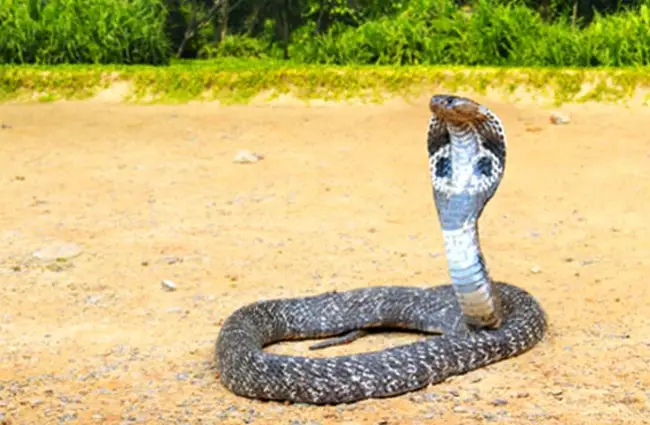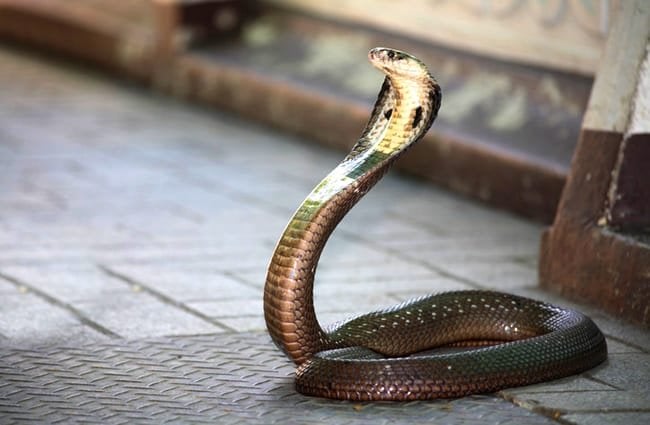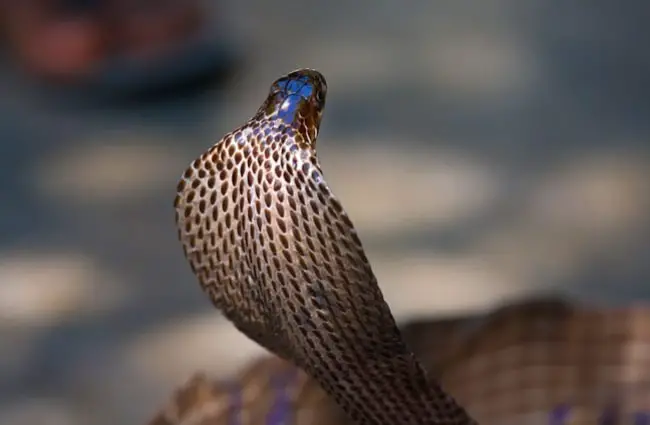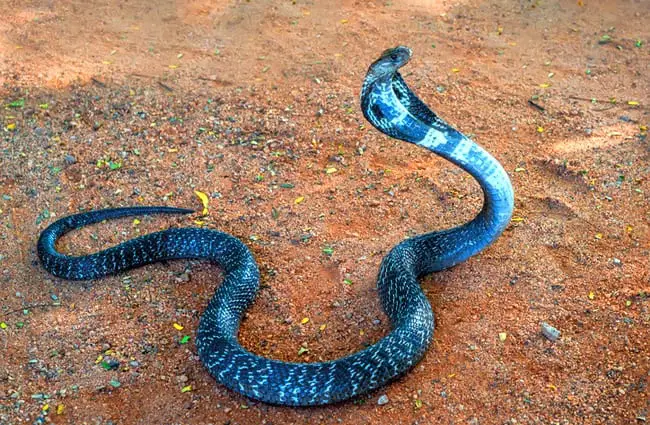The King Cobra, a name that conjures images of majesty and danger, is more than just a formidable reptile. It is a creature of incredible biological sophistication, an apex predator that commands respect across its vast Asian domain. For zoologists, naturalists, and even the casual observer, the King Cobra offers a fascinating window into the intricate world of snakes, revealing behaviors and adaptations rarely seen elsewhere in the animal kingdom.
Unveiling the Monarch: Basic Facts About the King Cobra
Known scientifically as Ophiophagus hannah, which literally translates to “snake-eater,” the King Cobra holds the undisputed title of the world’s longest venomous snake. Adults commonly reach lengths of 10 to 13 feet, with some exceptional individuals stretching over 18 feet. Despite its impressive size, this serpent is remarkably agile and graceful, moving with an almost fluid motion through its diverse habitats.
Its distinctive appearance includes a relatively narrow head, a powerful body, and the iconic hood, which it flares out when threatened. The coloration varies geographically, ranging from olive green, brown, or black, often with faint bands or chevrons across its body. This natural camouflage allows it to blend seamlessly into its surroundings, a crucial advantage for both hunting and evading larger predators.

A Realm of Green: King Cobra’s Habitat and Distribution
The King Cobra is native to a wide range of ecosystems across South and Southeast Asia. Its geographical distribution spans from India and Bangladesh through Myanmar, Thailand, Laos, Cambodia, Vietnam, Malaysia, Indonesia, and the Philippines, extending into southern China. This broad range highlights its adaptability to various environments.
King Cobras prefer dense forests, particularly evergreen forests, bamboo thickets, and mangrove swamps. They are often found near water sources such as rivers, streams, and lakes, as they are excellent swimmers and frequently hunt in aquatic environments. While primarily terrestrial, they are also adept climbers, occasionally ascending trees to bask or hunt. The presence of dense vegetation provides ample cover, crucial for an ambush predator of its size.
For an animal lover hoping to spot a King Cobra in the wild, understanding its preferred habitat is key. Focus on regions with undisturbed forest cover and proximity to water. However, it is important to remember that these snakes are shy and reclusive, making sightings rare and requiring extreme caution. They are most active during the day, particularly at dawn and dusk, but can also be observed at night.
The Apex Predator: King Cobra’s Diet and Hunting Strategy
True to its scientific name, the King Cobra is an ophiophagous specialist, meaning its diet primarily consists of other snakes. This unique dietary preference sets it apart from most other large predators. It preys on both venomous and non-venomous snakes, including rat snakes, pythons, kraits, and even other cobras. This specialized diet plays a significant role in regulating snake populations within its ecosystem.
When other snakes are scarce, the King Cobra may also consume other reptiles such as monitor lizards, and occasionally small mammals or birds. Its hunting strategy involves stealth and ambush. It uses its keen sense of smell, detected by its forked tongue, to track prey. Once a target is identified, the King Cobra strikes with incredible speed, delivering a potent dose of neurotoxic venom that quickly incapacitates its victim.

A Unique Courtship: Mating and Reproduction
The reproductive cycle of the King Cobra is one of the most fascinating aspects of its biology. Unlike most snakes, which simply lay their eggs and abandon them, the female King Cobra exhibits remarkable maternal care. During the breeding season, typically from January to April, males engage in ritualistic combat dances to win the right to mate with a female. These non-venomous duels involve intertwining bodies and attempting to pin the opponent’s head to the ground.
After mating, the female constructs a sophisticated nest for her eggs. This is a truly extraordinary behavior among snakes. She gathers leaves and other vegetation, piling them into a mound up to three feet high. She then lays a clutch of 20 to 50 eggs within this insulated chamber. The decomposing vegetation generates heat, providing a stable temperature for incubation.
The female remains near the nest throughout the 60 to 90-day incubation period, fiercely guarding her future offspring. She will aggressively defend the nest against any perceived threat, a testament to her dedication. Once the hatchlings emerge, typically around 18 to 22 inches long and already equipped with potent venom, they are left to fend for themselves. This maternal protection significantly increases the survival rate of the young King Cobras.
The Serpent’s Role: Ecosystem Contribution and Interactions
As an apex predator, the King Cobra plays a crucial role in maintaining the ecological balance of its habitat. By preying on other snakes, it helps to control their populations, which in turn can impact rodent and other small animal populations. This cascading effect highlights its importance in the food web. Without such predators, certain prey species could proliferate, leading to imbalances in the ecosystem.
Its interaction with other animals is primarily predatory. However, it also serves as prey for a select few, particularly large birds of prey when young, or mongooses, though a full-grown King Cobra is a formidable opponent even for a mongoose. Its presence indicates a healthy and biodiverse forest ecosystem.
A Legacy Etched in Culture: Human Interaction and Cultural Significance
The King Cobra’s imposing presence and potent venom have naturally led to a complex relationship with humans. In many cultures across its range, particularly in India and Southeast Asia, the King Cobra holds a revered and often sacred status. It is frequently depicted in mythology, folklore, and religious iconography, particularly within Hinduism and Buddhism, where it symbolizes power, protection, and fertility.
Snake charmers, though often using other cobra species, sometimes feature King Cobras, further cementing its place in popular imagination. However, it is crucial to understand that these performances are often stressful for the animals and do not reflect their natural behavior. The snake’s “dancing” is a defensive reaction to the charmer’s movements, not an enjoyment of the music.
Despite its cultural reverence, encounters with King Cobras can be dangerous. Habitat encroachment due to deforestation and human expansion brings these snakes into closer contact with human settlements. While generally shy and preferring to avoid confrontation, a cornered or threatened King Cobra will defend itself vigorously, displaying its hood, hissing loudly, and striking if necessary. Its venom is highly neurotoxic, affecting the nervous system and potentially leading to paralysis and respiratory failure if not treated promptly. Bites are medical emergencies requiring immediate antivenom administration.

Evolutionary Journey: A Glimpse into the Past
The King Cobra belongs to the family Elapidae, a group of venomous snakes characterized by their fixed front fangs. Its evolutionary history is intertwined with the diversification of snakes in Asia. While specific fossil records for Ophiophagus hannah are scarce, its lineage likely evolved alongside the rich diversity of other snake species in its range, developing its specialized ophiophagous diet as a unique ecological niche. This specialization allowed it to thrive by minimizing competition with other large predators for food resources. Its impressive size and potent venom are adaptations that support its role as a dominant predator of other snakes.
Fascinating Facts About the King Cobra
- Longest Venomous Snake: It holds the record, often exceeding 13 feet in length.
- Unique Nest Builder: The only snake known to build a nest for its eggs, complete with maternal guarding.
- Vocalizations: King Cobras can produce a distinctive growl or hiss, a low-frequency sound that is quite unusual for snakes and can be heard from a distance.
- Venom Volume: While not the most potent venom by toxicity per drop, the King Cobra can inject a massive amount of venom in a single bite, enough to kill an elephant or multiple humans.
- “Standing Up”: When threatened, a King Cobra can raise a significant portion of its body off the ground, sometimes standing as tall as a human, allowing it to look an adult human in the eye.
- Lifespan: In the wild, King Cobras can live for over 20 years.
- Intelligence: They are considered highly intelligent snakes, capable of learning and adapting to their environment.
Encountering a King Cobra in the Wild: What to Do
For hikers, researchers, or anyone venturing into King Cobra territory, understanding proper protocol during an encounter is vital. King Cobras are generally shy and will try to avoid humans. They are not inherently aggressive but will defend themselves if provoked or cornered.
- Stay Calm: Panic can lead to irrational decisions.
- Do Not Approach: Maintain a safe distance, at least 20 feet.
- Do Not Provoke: Never attempt to touch, capture, or harm the snake. Do not throw objects at it.
- Back Away Slowly: Move away calmly and deliberately, avoiding sudden movements.
- Give it Space: Allow the snake an escape route. It will likely retreat once it feels safe.
- Seek Medical Attention Immediately if Bitten: King Cobra bites are life-threatening. Call for emergency services and transport to a hospital with antivenom as quickly as possible. Do not attempt traditional remedies or tourniquets.

Caring for a King Cobra in Captivity: A Zookeeper’s Perspective
For zookeepers and aspiring zoologists interested in the specialized care of King Cobras, a deep understanding of their needs and inherent dangers is paramount. These are not pets, but highly dangerous animals requiring expert handling and specialized facilities.
Essential Tasks for Zookeepers:
- Secure Enclosure: Provide a spacious, escape-proof enclosure with strong locks and double doors. The enclosure must mimic its natural habitat with climbing structures, hiding spots, and a large water source for soaking.
- Environmental Control: Maintain precise temperature (typically 75-85°F or 24-29°C) and humidity levels (70-80%). A thermal gradient is crucial.
- Dietary Management: Provide a diet of appropriately sized feeder snakes or, in some cases, thawed rodents or birds if the individual has been conditioned to accept them. Monitoring feeding response and weight is important.
- Hygiene: Regular cleaning of the enclosure is essential to prevent disease. This requires specialized tools and protocols to ensure keeper safety.
- Health Monitoring: Daily visual checks for signs of illness, injury, or stress. Regular veterinary check-ups by a reptile specialist are necessary.
- Enrichment: Offer environmental enrichment to stimulate natural behaviors, such as varying substrate, rearranging decor, or providing new climbing opportunities.
- Venom Management: If the facility is involved in venom extraction for antivenom production, this is a highly specialized and dangerous procedure performed by trained professionals.
What to Avoid:
- Direct Handling: Never handle a King Cobra directly unless absolutely necessary for medical procedures, and then only with specialized tools and multiple trained personnel.
- Underestimating its Speed and Reach: King Cobras are incredibly fast and can strike a considerable distance.
- Inadequate Security: Any lapse in enclosure security can have catastrophic consequences.
- Stressful Environments: Loud noises, constant human presence, or improper habitat can cause stress, leading to health issues and increased defensive behavior.
- Improper Feeding: Feeding live venomous snakes to a King Cobra in captivity is generally discouraged due to the risk of injury to the King Cobra.
A Call for Conservation
Despite its formidable reputation, the King Cobra faces significant threats in the wild. Habitat loss due to deforestation, agricultural expansion, and human development is the primary concern. Poaching for traditional medicine, skin, and the illegal pet trade also contributes to population decline. The King Cobra is listed as “Vulnerable” by the IUCN, highlighting the urgent need for conservation efforts. Protecting its forest habitats is not only crucial for the King Cobra but also for the myriad of other species that share its ecosystem, including many other snakes it preys upon. Understanding and respecting this magnificent serpent is the first step towards ensuring its survival for future generations.

![Red Angus Closeup of a beautiful Red Angus cowPhoto by: U.S. Department of Agriculture [pubic domain]https://creativecommons.org/licenses/by/2.0/](https://animals.net/wp-content/uploads/2020/03/Red-Angus-4-238x178.jpg)




![Red Angus Closeup of a beautiful Red Angus cowPhoto by: U.S. Department of Agriculture [pubic domain]https://creativecommons.org/licenses/by/2.0/](https://animals.net/wp-content/uploads/2020/03/Red-Angus-4-100x75.jpg)

